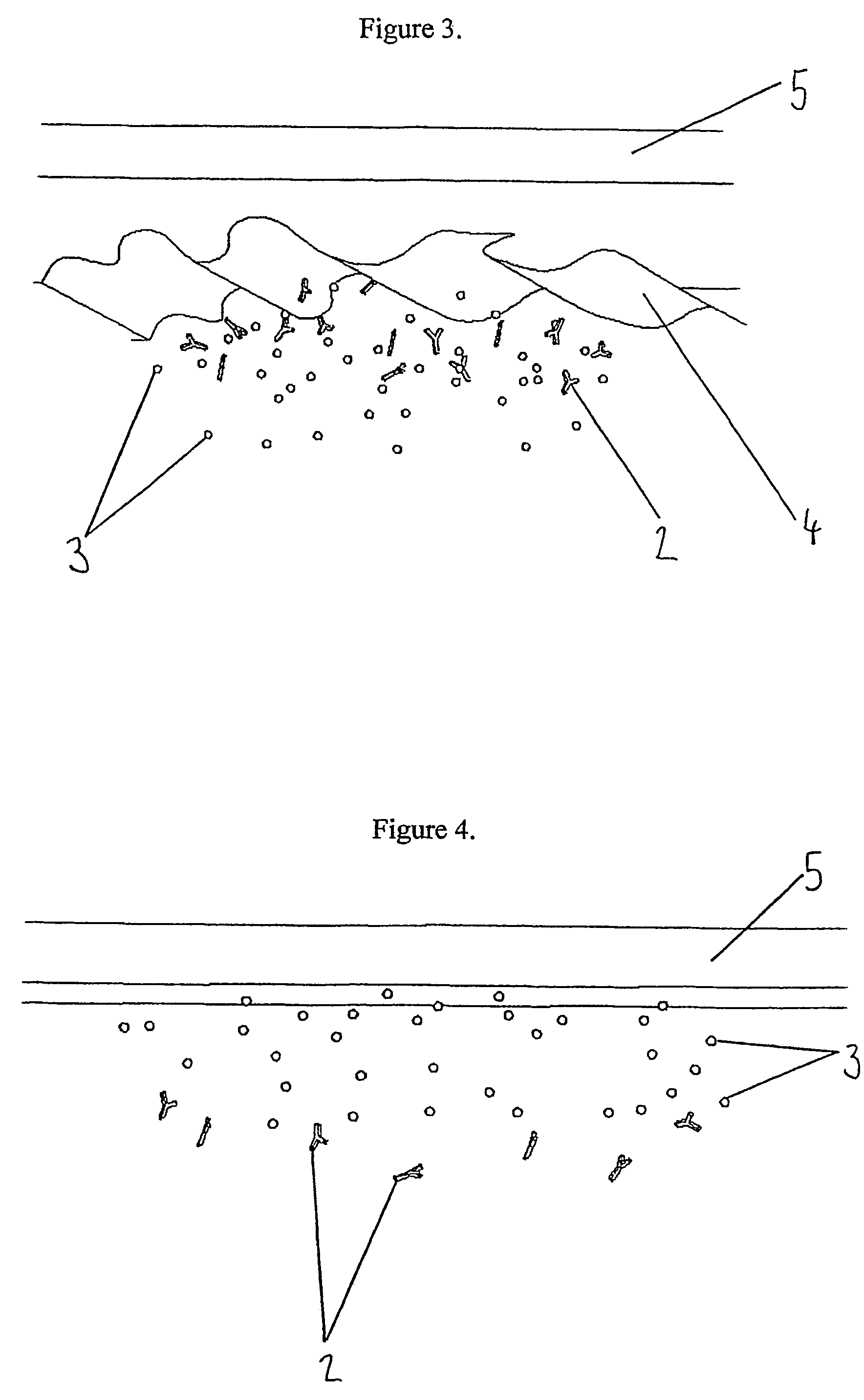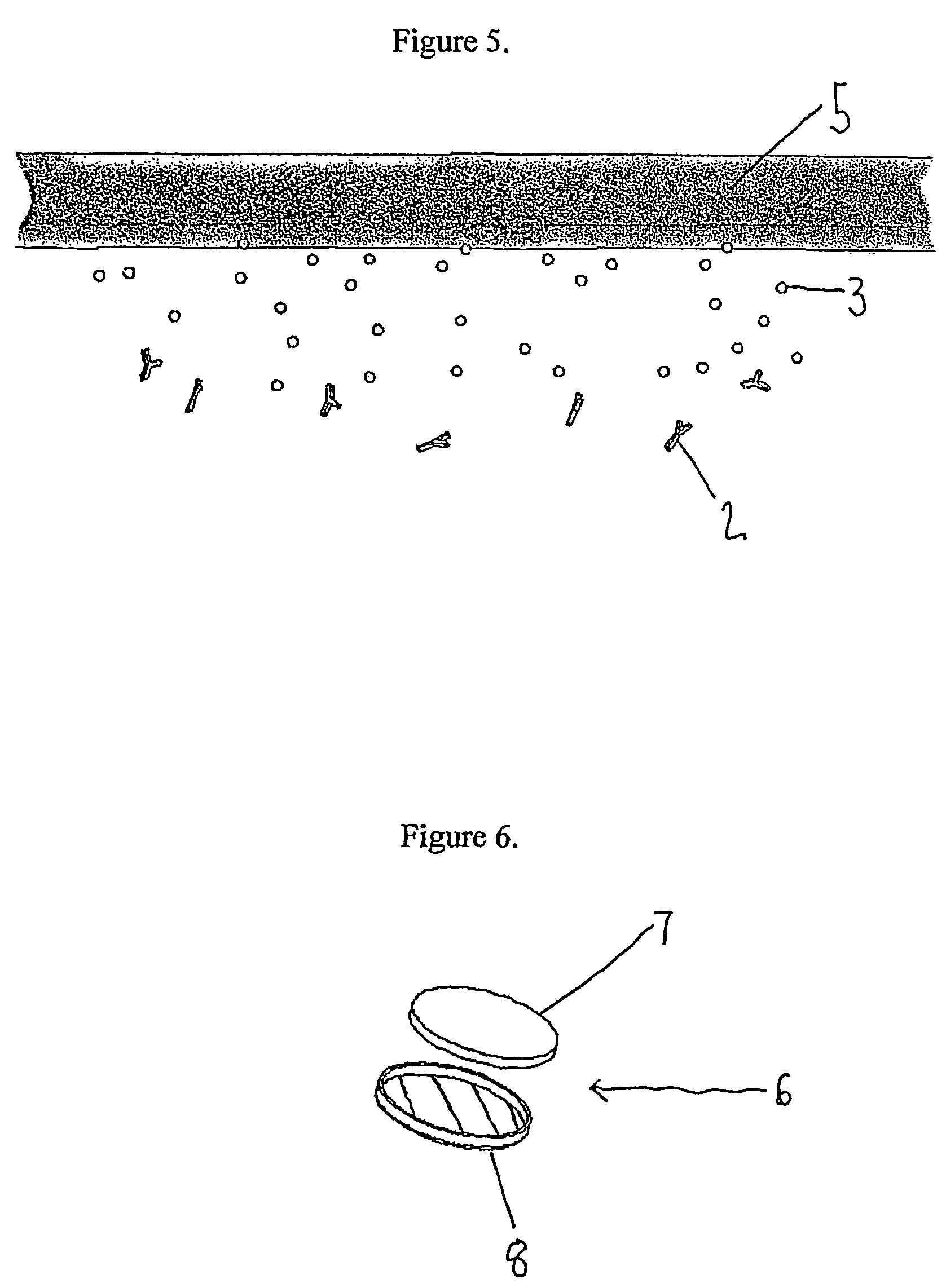Indicator for in-situ detecting of lysozyme
a lysozyme and insitu detection technology, applied in the direction of chemical indicators, instruments, food testing, etc., can solve the problems of inability to provide an indication of wound condition, inconvenient operation, and inability to detect insitu, so as to achieve convenient determination and use the effect of working li
- Summary
- Abstract
- Description
- Claims
- Application Information
AI Technical Summary
Benefits of technology
Problems solved by technology
Method used
Image
Examples
example 1
Formation of Layer (a)
[0095]A chitosan (poly (D-glucosamine) of formula I) membrane
[0096]
Formula I
was formed for use as layer (a) using the method described below:[0097]A homogenous solution of 1% (w / w) purified 60% chitosan was prepared in 1% acetic acid by continuous stirring overnight at 22° C. (room temperature).[0098]20 g of the solution was transferred to a sterile polystyrene petri dish (120×120×17 mm) placed on a level surface at 30° C. for several days until the solution was dry and a uniform membrane was formed.[0099]The resulting membrane was removed carefully and neutralized by immersion for 1 hour in 100 ml 2% (w / v) sodium hydroxide solution.[0100]The film was then washed in distilled water several times over a period of 1 hour.[0101]The swollen film was then placed between glass plates and placed in a drying oven until dry.[0102]The film was then removed from the glass plate.
[0103]60% deacetylated chitosan was used as it had been determined experimentally that this lev...
example 2
Determination of Concentration of Signalling Substance
[0104]Meldola's blue (formula II) and nitro blue tetrazolium (formula III) were chosen for use as indicators.
[0105]
Formula II
[0106]
Formula III
[0107]Meldola's blue (8-dimethylamino-2,3-benzophenoxazine) acts as an electron donor to tetrazolium salts, such as nitro blue tetrazolium to form an insoluble formazan product. This product is coloured and precipitates out of solution, giving a visual indication of the presence of electron donors such as NADH. The reaction is shown below:
[0108]
[0109]Optimization experiments were carried out to determine the concentrations of meldola's blue and nitro blue tetrazolium in order that the formation of the formazan product (and therefore colour) was increased, and that allowed the meldola's blue to be continuously recycled. NADH was used as the electron donor. The concentrations of meldola's blue (blue crystals) and nitro blue tetrazolium (clear yellow solution) were kept as low as possible so t...
example 3
Signalling Presence of Substance
[0122]A simple cell with two chambers separated by a vertical wall of chitosan as produced in Example 1 was constructed to demonstrate the degradation of chitosan in a time-dependent manner in the presence of lysozyme. The left hand chamber was filled with a blue coloured dye to which lysozyme was added. The right hand chamber contained water. The chitosan between the two chambers prevented flow of liquid between them.
[0123]The diffusion of colour between the chambers was examined for up to 30 minutes. Appropriate controls were run where no lysozyme was present.
[0124]Two concentrations of lysozyme (25 and 50 μg per ml) were used, and the strength of colour visible in the second chamber up to 30 minutes was determined. A rough estimation of the relative rate of degradation of the chitosan by lysozyme was therefore given. The results are presented in the table below, the stronger the colour observed, the more positives indicated. Where no lysozyme was p...
PUM
| Property | Measurement | Unit |
|---|---|---|
| temperature | aaaaa | aaaaa |
| absorbance | aaaaa | aaaaa |
| concentrations | aaaaa | aaaaa |
Abstract
Description
Claims
Application Information
 Login to View More
Login to View More - R&D
- Intellectual Property
- Life Sciences
- Materials
- Tech Scout
- Unparalleled Data Quality
- Higher Quality Content
- 60% Fewer Hallucinations
Browse by: Latest US Patents, China's latest patents, Technical Efficacy Thesaurus, Application Domain, Technology Topic, Popular Technical Reports.
© 2025 PatSnap. All rights reserved.Legal|Privacy policy|Modern Slavery Act Transparency Statement|Sitemap|About US| Contact US: help@patsnap.com



